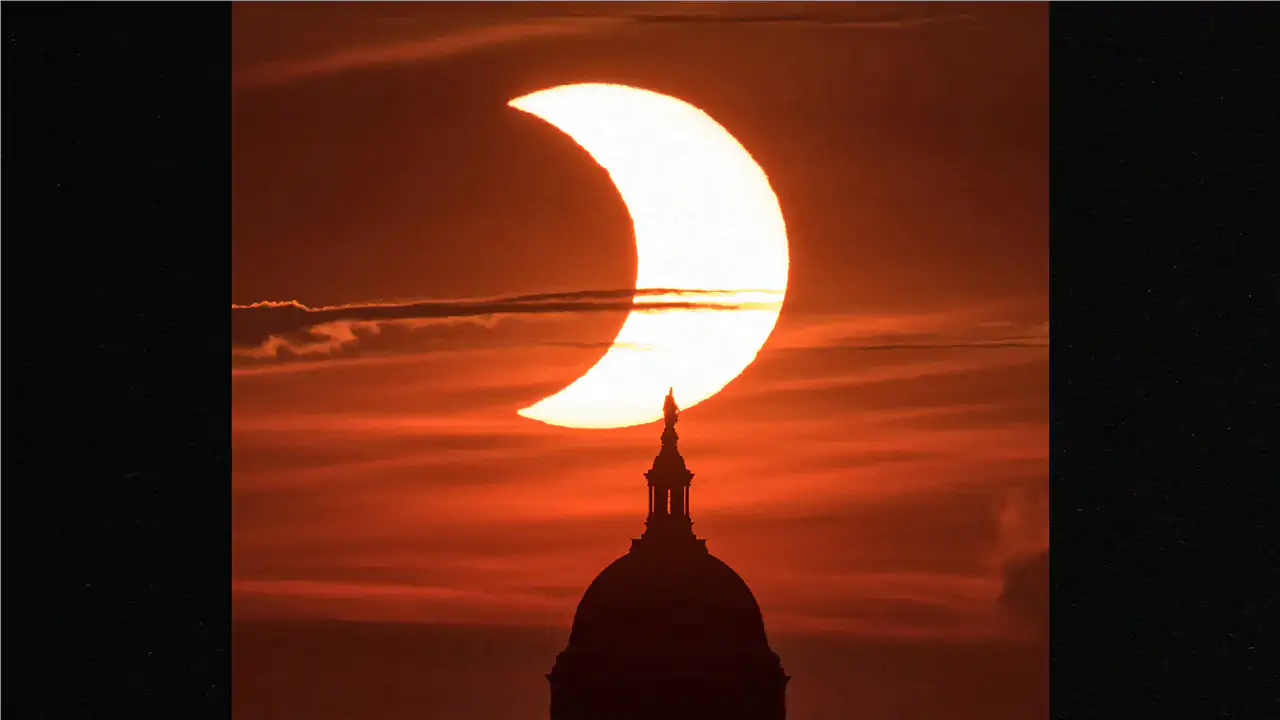It was a long shot to trust the northern New England weather in early April, especially after a strange winter of warm spells followed by massive snowstorms. But hundreds of thousands of people gambled, or trusted their weather apps, and, as the atmospheric gods would have it, we were all in for a spectacular celestial treat. Clear blue skies, low humidity, great visibility. I drove for about 2.5 hours from Hanover to the north of New Hampshire with my two sons to an iconic mountain outcrop called Dixville Notch, part of a state park. There, we were to hike up for under a mile to reach Table Rock, a narrow and somewhat flat granite slab with open vistas of the surroundings and, of course, of the sky.
As luck would have it, the trail was still snowy and icy, making for a fun adventure, half spent on our behinds. Once we reached the top, we found out that our original idea wasn’t so original after all: An enthusiastic crowd was hovering over the rock, all eagerly waiting and huddled over, battling the cold frigid wind. I suggested quitting and going back down, but, as my 17-year-old reminded me, “Think of Shackleton stuck in the Antarctic winter land for 18 months, dad. This is nothing!” I did. Poor Shackleton. But he didn’t have a ship stuck in ice and a crew to feed. So, since we still had several hours to totality, we made the wimpy but wise decision to go down to the road, away from the wind and cold, in search of a less crowded spot.
We found a nice niche along the road, with clear views to the southwest sky, and waited, eyes fixed on the Sun, mouths agape, as the Moon slowly ate away at the solar disk. To help pass the time, I explained to my sons that total eclipses are a product of a strange and almost eerie cosmic coincidence — one that makes Earth an even rarer world in the galaxy and, by proxy, in the Universe.
We can witness total eclipses on Earth because our Moon can cover almost perfectly the disk of the Sun. How can this happen? It has to do with the relative distances and sizes of the two objects. For an eclipse to reach totality, two ratios need to compensate one another: the ratio of the distance between the planet and its host star (let’s call it DPS) and of the planet and its moon (let’s call it DPM), DPS/ DPM, needs to be the same, or very close, to the ratio of the sizes of the host star (RS) and the moon (RM), RS/RM, that is: DPS/ DPM = RS/RM
In the case of our Moon and Sun, the ratio is about 390. So, the Sun is 390 times farther away than the Moon, and its radius is 400 times bigger than the Moon’s. The two ratios are almost the same — close enough for total coverage.
The skies go dark and the Sun goes black, surrounded by an eerie crown of sharp, other-worldly silver light: the solar corona. The skies seemed to be looking down at us, judging. We could see Venus and Jupiter and a few stars at 3:30 p.m. For almost three minutes, the day was gone, held prisoner by the celestial spectacle. Everyone grew quiet, birds stopped chirping, and time seemed to stand still. Each in their own way, all strangers to one another, felt a common bond, a visceral connection to a mystery bigger than we are — a mystery that takes us back to our own shared cosmic origins, to the oddness of our existence and ability to ponder. No one who watches a total eclipse comes out of the experience the same.
As we walked back to the car, having no idea that the drive home would amount to one of the biggest traffic jams in our local history, I thought again about those numbers: the two ratios that compensate each other almost perfectly over the vast astronomical distances that separate us from our moon and star. How incredible is it that the only planet that hosts life in our Solar System — a life form that can predict celestial events — is also the planet where all this is possible?
Total eclipses are certainly a rare event in the Universe, and we happen to live on the planet that provides us with this most beautiful natural phenomenon. How many minds in the past were both terrorized and awed by this sudden disappearance of daylight? How many wars stopped, how many rituals were enacted and prayers addressed to the gods above, humbling us with such performance? Since then, we have developed a scientific narrative of the skies and an understanding of what actually happens up there as the sun goes dark. As I turned the car on, I could see my two sons glowing with delight. I smiled, knowing that a memory had been etched forever into their minds, a bridge between their lives and the rest of the Universe.


